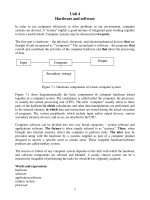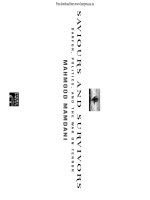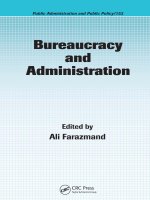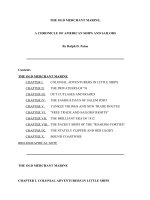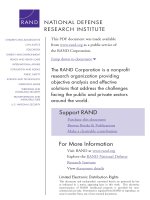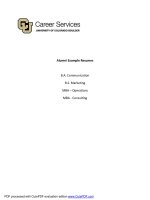Charter School Operations and Performance pptx
Bạn đang xem bản rút gọn của tài liệu. Xem và tải ngay bản đầy đủ của tài liệu tại đây (624.55 KB, 132 trang )
A RAND INFRASTRUCTURE, SAFETY, AND ENVIRONMENT PROGRAM
Environment, Energy, and Economic Development
For More Information
Visit RAND at www.rand.org
Explore the RAND Environment, Energy, and
Economic Development Program
View document details
Support RAND
Purchase this document
Browse Reports & Bookstore
Make a charitable contribution
Limited Electronic Distribution Rights
is document and trademark(s) contained herein are protected by law as indicated in a notice
appearing later in this work. is electronic representation of RAND intellectual property is
provided for non-commercial use only. Unauthorized posting of RAND electronic documents to
a non-RAND website is prohibited. RAND electronic documents are protected under copyright
law. Permission is required from RAND to reproduce, or reuse in another form, any of our
research documents for commercial use. For information on reprint and linking permissions,
please see RAND Permissions.
Skip all front matter: Jump to Page 16
e RAND Corporation is a nonprot institution that
helps improve policy and decisionmaking through
research and analysis.
is electronic document was made available from
www.rand.org as a public service of the RAND
Corporation.
CHILDREN AND FAMILIES
EDUCATION AND THE ARTS
ENERGY AND ENVIRONMENT
HEALTH AND HEALTH CARE
INFRASTRUCTURE AND
TRANSPORTATION
INTERNATIONAL AFFAIRS
LAW AND BUSINESS
NATIONAL SECURITY
POPULATION AND AGING
PUBLIC SAFETY
SCIENCE AND TECHNOLOGY
TERRORISM AND
HOMELAND SECURITY
is product is part of the RAND Corporation monograph series.
RAND monographs present major research ndings that address the
challenges facing the public and private sectors. All RAND mono-
graphs undergo rigorous peer review to ensure high standards for
research quality and objectivity.
Choosing a New
Organization for
Management and
Disposition of
Commercial and
Defense High-Level
Radioactive Materials
Lynn E. Davis, Debra Knopman, Michael D. Greenberg,
Laurel E. Miller, Abby Doll
A RAND INFRASTRUCTURE, SAFETY, AND ENVIRONMENT PROGRAM
Environment, Energy, and Economic Development
Choosing a New
Organization for
Management and
Disposition of
Commercial and
Defense High-Level
Radioactive Materials
Lynn E. Davis, Debra Knopman, Michael D. Greenberg,
Laurel E. Miller, Abby Doll
With Paul Steinberg, Bruce R. Nardulli, Tom LaTourrette,
Noreen Clancy, Zhimin Mao
A RAND INFRASTRUCTURE, SAFETY, AND ENVIRONMENT PROGRAM
Environment, Energy, and Economic Development
Prepared for the U.S. Department of Energy
The RAND Corporation is a nonprofit institution that helps improve
policy and decisionmaking through research and analysis. RAND’s
publications do not necessarily reflect the opinions of its research clients
and sponsors.
R
®
is a registered trademark.
© Copyright 2012 RAND Corporation
Permission is given to duplicate this document for personal use only, as
long as it is unaltered and complete. Copies may not be duplicated for
commercial purposes. Unauthorized posting of RAND documents to
a non-RAND website is prohibited. RAND documents are protected
under copyright law. For information on reprint and linking permissions,
please visit the RAND permissions page ( />publications/permissions.html).
Published 2012 by the RAND Corporation
1776 Main Street, P.O. Box 2138, Santa Monica, CA 90407-2138
1200 South Hayes Street, Arlington, VA 22202-5050
4570 Fifth Avenue, Suite 600, Pittsburgh, PA 15213-2665
RAND URL:
To order RAND documents or to obtain additional information, contact
Distribution Services: Telephone: (310) 451-7002;
Fax: (310) 451-6915; Email:
Library of Congress Cataloging-in-Publication Data is available for this publication.
ISBN: 978-0-8330-7640-3
This research was sponsored by the U.S. Department of Energy and was
conducted in the Environment, Energy, and Economic Development
Program within RAND Infrastructure, Safety, and Environment, a
division of the RAND Corporation.
iii
Preface
Following the President’s decision in January 2010 to withdraw the license application
for a geologic repository at Yucca Mountain, Nevada, the Secretary of Energy estab-
lished the Blue Ribbon Commission on America’s Nuclear Future (BRC) to consider
alternatives to the nation’s current institutional arrangements for management and
disposition of used fuel and defense high-level nuclear waste. In February 2012, the
BRC issued its nal report.
1
Among its recommendations was a call for a new, single-
purpose organization to be established to replace the Oce of Civilian Radioactive
Waste Management (OCRWM) in the U.S. Department of Energy (DOE) that had
been established under the authority of the 1982 Nuclear Waste Policy Act.
2
e BRC suggested that a congressionally chartered federal corporation oers
the most promising model, but the commission left open the possibility of alterna-
tive concepts to achieve the desired ends. In response to this recommendation, DOE
asked the RAND Corporation to examine alternative organizational models for such a
new management and disposition organization (MDO). Our study supports the work
of DOE’s Oce of Nuclear Energy and the Management and Disposition Working
Group (MDWG) formed to consider implementation options and activities.
The RAND Environment, Energy, and Economic Development Program
is research was conducted in the Environment, Energy, and Economic Development
Program (EEED) within RAND Infrastructure, Safety, and Environment (ISE). e
mission of ISE is to improve the development, operation, use, and protection of soci-
ety’s essential physical assets and natural resources and to enhance the related social
assets of safety and security of individuals in transit and in their workplaces and com-
munities. e EEED research portfolio addresses environmental quality and regula-
tion, energy resources and systems, water resources and systems, climate, natural haz-
1
BRC, 2012.
2
Pub. L. 97-425.
iv Management and Disposition of Commercial and Defense High-Level Radioactive Materials
ards and disasters, and economic development—both domestically and internationally.
EEED research is conducted for governments, foundations, and the private sector.
Questions or comments about this report should be sent to the project leaders,
Debra Knopman () and Lynn Davis (Lynn_Davis@rand.
org). Information about EEED is available online ( />html). Inquiries about EEED projects should be sent to the following address:
Keith Crane, Director
Environment, Energy, and Economic Development Program, ISE
RAND Corporation
1200 South Hayes Street
Arlington, VA 22202-5050
703-413-1100, x5520
v
Contents
Preface iii
Figures
vii
Tables
ix
Summary
xi
Acknowledgments
xxiii
Abbreviations
xxv
CHAPTER ONE
Introduction 1
Key Findings of the Blue Ribbon Commission
1
e Concept: A Federal Corporation for Waste Management
2
Study Objectives and Approach
4
CHAPTER TWO
Learning Lessons from the Past 7
Assessment of the Prior Organizational Design
7
Governance and Leadership
8
Funding and Budget Control
9
Siting Process
11
Federal Procurement and Personnel Policies
12
Public Trust
13
Conclusions
15
CHAPTER THREE
Exploring Potential Organizational Models 17
Comparison of Organizational Models
19
Federal Government Corporation
19
Federally Chartered Private Corporation
28
Independent Government Agency
31
Dierences and Similarities of the Organizational Models
35
Conclusions
37
vi Management and Disposition of Commercial and Defense High-Level Radioactive Materials
CHAPTER FOUR
Matching Organizational Models to Critical Organizational Attributes 39
Mission and Responsibilities
39
Core Responsibilities
40
Management and Support Responsibilities
43
Performance Goals
43
Critical Organizational Attributes
45
Structural and Procedural Features and Analysis of Organizational Models
50
Discriminating Among Organizational Models
62
CHAPTER FIVE
Designing a New Management Disposition Organization 65
Policymakers’ Choices
66
Step 1: e President’s Role
66
Step 2: Congress’s Role
68
Step 3: MDO Funding
70
Step 4: Other Organizational Features
70
Considerations Related to Choice of Organizational Form
73
Government Responsibility for Catastrophic Risk
73
Evolution of the MDO as Its Roles Change Over Time
74
Making the Choices
75
APPENDIXES
A. Comparison of the Tennessee Valley Authority and the
Bonneville Power Administration
77
B. Summary of Organizational Characteristics of Canadian and Swedish MDOs
89
C. List of Mixed-Ownership Government Corporations and Wholly Owned
Government Corporations
91
References
93
vii
Figures
S.1. Framework for Linking Responsibilities, Performance Goals,
Attributes, and Features
xiii
S.2. e MDO’s Relationship to the President
xiv
S.3. e MDO’s Relationship to the Congress and Funding Source
xvi
S.4. Other Organizational Features of the MDO
xviii
3.1. e Organizational Spectrum: Private to Public Sector
17
4.1. Framework for Linking Responsibilities, Performance Goals,
Attributes, and Features
39
4.2. A Notional View of the Phasing of the MDO’s Responsibilities
41
5.1. e MDO’s Relationship to the President
66
5.2. e MDO’s Relationship to the Congress and Funding Source
69
5.3. Other Organizational Features of the MDO
71
ix
Tables
3.1. Comparison of Organizational Models 20
4.1. Core Responsibilities of the MDO
40
4.2. Organizational Attributes Needed to Achieve Performance Goals
46
4.3. Structural and Procedural Features at Produce Organizational Attributes
Identied in Table4.2
51
A.1. Comparison of the Tennessee Valley Authority and the Bonneville Power
Administration
78
B.1. Major Characteristics of Canadian and Swedish MDOs
90
xi
Summary
Introduction
Finding ways to safely store and ultimately dispose of used fuel from commercial and
defense reactors as well as high-level nuclear waste from defense and other operations
has been on the national policy agenda for decades and remains a matter of consider-
able debate. At the request of the President, the Secretary of Energy convened the Blue
Ribbon Commission on America’s Nuclear Future (BRC) in 2010 “to conduct a com-
prehensive review of policies for managing the back end of the nuclear fuel cycle” and
to recommend a new strategy.
3
e BRC, among its many recommendations, called for the creation of an orga-
nization chartered by Congress and structured as a federal government corporation.
4
e U.S. Department of Energy (DOE) asked RAND to support its eort to respond
to the recommendations of the BRC by looking at dierent organizational models for
a new, single-purpose organization to manage and dispose of used fuel and high-level
defense and other nuclear waste—a management and disposition organization, hereaf-
ter referred to as an MDO.
Looking Back
We rst took a retrospective look to ask what the major problems were in nuclear waste
management in the past decades and where responsibility for those problems lies. In so
doing, we examined ve areas: (1)governance and leadership, (2)funding and budget
control, (3)the siting process, (4)procurement and personnel rules, and (5)the public
trust. What we discovered was that the organizational design of the Oce of Civilian
Radioactive Waste Management (OCRWM) within DOE contributed less to the prob-
lems than the Nuclear Waste Policy Act (NWPA) itself and subsequent congressional
and executive branch actions. ese actions included most notably the 1987 amend-
ments, which designated Yucca Mountain as the only candidate repository site, over
3
DOE, 2010a.
4
BRC, 2012, p. x.
xii Management and Disposition of Commercial and Defense High-Level Radioactive Materials
the objections of Nevada, and changes in budgeting that severely restricted the Secre-
tary of Energy’s access to the Nuclear Waste Fund (NWF). In the light of OCRWM’s
history and the actions of Congress and various administrations as a whole, perhaps
the most important lesson to be drawn is that organizational form may only have a
limited eect on a program’s performance; that is, a well-designed organization is a
necessary but not sucient condition for success. As awed as OCRWM’s program
implementation may have been at times, it is dicult to imagine that any organization
could have successfully executed the program in the absence of both public support in
the aected state and sustained funding from Congress, itself an indicator of public
support.
Organizational Models
We explored potential organizational models, paying specic attention to federal gov-
ernment corporations (GOVCORPs) but also to federally chartered private corpora-
tions (PRIVCORPs) and independent government agencies (IGAs). In Chapter ree,
we describe their characteristics—in terms of such things as the charter, direct over-
sight, the role of the President and the White House, the role of Congress, funding,
and personnel management, procurement, and contracting—and how they perform
their specic missions. What we found was that the models involve dierent avenues
for blending the features of a private-sector organization (e.g., independence and inter-
nal exibility) and of a government agency (e.g., public trust, political oversight and
accountability, and political inuence). e key takeaway of this examination lies in
the exibility the U.S. government has in choosing among the dierent organizational
models but also the specic characteristics of each of the models.
Analysis Framework
Although there could be reasons for picking one organizational model over another,
we discovered that more analysis was required, with a focus on the critical attributes an
organization needs to achieve its performance goals and carry out its responsibilities.
Using our analysis framework, we dened the key responsibilities of a new MDO that
derive from its mission, its organizational performance goals, the critical organizational
attributes needed to meet those performance goals, and the various structural and pro-
cedural features necessary to perform those critical attributes. See Figure S.1.
Next, we matched the structural and performance features with each of the orga-
nizational models (PRIVCORP, GOVCORP, and IGA) to determine which of these
were present or could be built in to each model. From this analysis, we came to the
view that several critical attributes are weaker in or missing from the PRIVCORP
Summary xiii
model, including public accountability, public interest mission, and linkages to the
executive branch and Congress that would ensure the political credibility and inu-
ence needed for siting. (Indeed, independence from the President and Congress is a
primary rationale for a PRIVCORP.) Although these features could theoretically be
written into a PRIVCORP’s charter, achieving these would be prohibitively dicult
for a U.S. private corporation whose primary loyalty is to its stockholders in earning a
prot. However, the critical attributes exist or can be built into the two other organi-
zational models, an IGA and a GOVCORP, given the many dierent variations in the
characteristics that these organizations can take.
Designing a New MDO
In designing a new MDO, policymakers will need to go through a series of steps that
will involve a number of choices, rst about the relationship of the MDO to the Presi-
dent, next about Congress’s role, third about the source of the MDO’s funding, and
then the role of stakeholders and other MDO organizational features. We begin with
the President and Congress because their roles are critical in setting the tone and shap-
ing the relationship among the MDO, stakeholders, and the public.
Step 1: The President’s Role
e critical choice for policymakers is how the MDO should relate to the President,
i.e., whether it should be a direct relationship, as in an IGA, or a relationship that is
largely independent of the President, as in a GOVCORP. See Figure S.2.
• Direct relationship: Reporting directly to the President, as with an IGA, ensures
that the public interest is taken into account in all the operations of the MDO.
e inuence residing with the President would be available to achieve the siting
of the storage and disposal facilities, and the executive branch would be able to
inuence MDO operations in ways to make certain that the siting tasks are being
accomplished; the storage, transport, and disposal of used fuel and nuclear waste
Figure S.1
Framework for Linking Responsibilities, Performance Goals, Attributes, and Features
RAND MG1230-S.1
Responsibilities
Performance
goals
Critical
organizational
attributes
Structural and
procedural
features
xiv Management and Disposition of Commercial and Defense High-Level Radioactive Materials
are being carried out safely; and situations do not arise in which a government
bailout would be needed.
• Independent relationship: Greater independence from the President, as is typi-
cally the case in a GOVCORP, insulates the activities of the MDO from the
turnover of administrations, provides the authority necessary to make decisions
on siting without political interference, and allows exibility in siting negotia-
tions, operations (including contracting and procurement), and personnel policy.
In the case of an IGA, policymakers would have the choice of whether the MDO
would report to the President directly or through the Secretary of Energy, as is the case
today with Bonneville Power Administration (BPA). is would be dierent from the
past when OCRWM was an oce inside DOE. Reporting through the Secretary of
Energy would be a way for MDO activities to continue tobe closelyintegrated with
other DOE-related activities. e case for having the MDO report directly to the
President rests largely on the need to make a break from past problems associated with
DOE’s management of used fuel and defense high-level nuclear waste.
Having chosen either an IGA or a GOVCORP, policymakers will have some ex-
ibility to build into the organization features to enhance its prospects of achieving its
Figure S.2
The MDO’s Relationship to the President
NOTE: OMB = Office of Management and Budget.
RAND MG1230-S.2
Define relationship of MDO to President
DOE
Secretary
Governance
Presidential review
Judicial review
Presidential review
Judicial review
Review of siting
decisions
Led by MDO leadership
Led by Domestic Policy Council/
OMB/Secretary of Energy with
MDO representation
Executive
Interagency
Group
Board of Directors
Administrator/
Board of Directors/Commission
Leadership tenure
and representation
Leadership tenure
and representation
GOVCORP
IGA
Summary xv
performance goals and lessen some of the potential disadvantages associated with the
organizational form chosen. ey would do this by making decisions with respect to
each of the boxes in Figure S.2.
Independent Government Agency
If an IGA is preferred, policymakers would rst need to choose its supervisory struc-
ture, i.e., whether the agency would be led by a governing board (e.g., the Federal
Reserve), a commission (e.g., Nuclear Regulatory Commission [NRC]), or a single
administrator (e.g., BPA, National Aeronautics and Space Administration [NASA]).
While maintaining accountability, steps could then be taken to shape the governance
of an IGA to achieve some degree of political insulation, e.g., by mandating a bal-
ance among political aliations for a multimember board or commission. To further
build political insulation and organizational stability, policymakers could preclude
presidential review of the MDO’s major decisions. e IGA administrator or board/
commission chairman could also be designated to lead an interagency group to ensure
the political credibility and inuence necessary to carry out the MDO’s responsibili-
ties, particularly in siting.
Government Corporation
To increase the accountability of the leadership in a GOVCORP, policymakers could
require in the legislative charter that the President nominate the members of the
MDO’s board of directors and mandate that their terms be relatively short and subject
to periodic renewal. In addition to dening what experience and expertise they wished
to have on the board, policymakers could designate a member of the executive branch
to serve on the board. As a GOVCORP is designed to be insulated from presidential
involvement, policymakers could make provision for some presidential role and review
of the MDO’s major decisions.
To tap into the resources of the federal government for providing the incentives
that will be necessary to achieve the siting of the facilities and to gain inuence over the
activities of the executive branch agencies, including the regulators, policymakers could
set up, under the Domestic Policy Council, Oce of Management and Budget, or the
Secretary of Energy, an ad hoc group with representation from executive departments,
the regulatory agencies, and the GOVCORP leadership.
Step 2: Congress’s Role
Policymakers will also need to address the relationship of the MDO to Congress and
focus on oversight and the congressional role in decisions on siting. ese will be inde-
pendent of which organizational model is chosen. See Figure S.3.
Policymakers will need to decide whether the Senate will have a role in conrm-
ing the leadership of the MDO: the board of directors, commission, or agency admin-
istrator. If there is a role in conrmation, the Senate will need to put in place processes
to avoid delays that could leave the MDO without the leadership it needs.
xvi Management and Disposition of Commercial and Defense High-Level Radioactive Materials
Policymakers will also need to make decisions as to which committees will exer-
cise oversight over the operations and decisions of the MDO and through what types
of testimonies and reports (on, for example, strategic plans, management and nancial
operations). To gain insight into the conduct of MDO activities, Congress could create
an independent IG who is required to submit annual public reports and require audits
by the GAO.
Finally, policymakers will need to decide whether Congress will be given any spe-
cic role in the various decisions that will be called for in the siting processes, i.e., the
locations of the facilities and the agreements negotiated with states, tribes, and local
communities. One possibility is for Congress to ratify these MDO decisions (e.g., as
the Senate raties a treaty in an “up-down” vote); another possibility is that Congress
approve or disapprove these decisions (e.g., as is done with the recommendations of the
Base Closing and Realignment Commission to close military facilities).
History has shown that, under the terms and conditions of the NWPA, Con-
gress fully involved itself in site selection, funding, and regulatory decisions and, in so
Figure S.3
The MDO’s Relationship to the Congress and Funding Source
NOTE: IG = inspector general.
RAND MG1230-S.3
GOVCORPIGA
Define relationship of MDO to Congress
Define MDO funding
None
Ratify
Approve/disapprove
Committees, reports
Senate confirmation
of leadership
Independent IG, GAO audits
None
Ratify
Approve/disapprove
Committees, reports
Senate confirmation
of leadership
Independent IG, GAO audits
Self-sustaining
Presidential budget and
congressional appropriation
Self-sustaining
Presidential budget and
congressional appropriation
Oversight
Source
Role in siting decision
Summary xvii
doing, undermined public trust and condence in the processes. Although Congress
does have an important and constructive role to play in the future, there is an inherent
tension between a consent-based siting approach and giving Congress the authority
to veto agreements made between the MDO and consenting states, tribes, and local
communities.
Step 3: MDO Funding
Perhaps the most important issue that policymakers will face is what will be the source
of the MDO’s funding, i.e., whether it will receive annual congressional appropria-
tions or be able to fund its expenditures from operating revenues or other resources
(i.e., “self-sustaining”). See Figure S.3. e decision on how the MDO is funded is
independent of whether the organization is a GOVCORP or an IGA. e Tennessee
Valley Authority (TVA) (a GOVCORP) has a dedicated funding stream; the NRC (an
IGA) has a dedicated funding stream but is subject to an annual appropriation, and
Amtrak (a GOVCORP) has both dedicated funding streams and annual appropria-
tions. NASA (an IGA) receives annual appropriations.
In the case of annual appropriations, the Senate and House will be required to
authorize and appropriate the funds, and the MDO will need to submit its budget
through OMB and provide the supporting budget justication and documentation to
the various congressional oversight committees. Even if funds are made available on
a self-sustaining basis through a dedicated funding source, OMB and the Congress
could still exercise oversight by requiring the MDO to submit quarterly and annual
nancial and management reports.
Step 4: Other Organizational Features
Whether an IGA or GOVCORP model is chosen, policymakers will need to dene
other features of a new MDO and include these in the enabling legislation: one is how
the MDO will relate to its stakeholders, another is how it will be treated by federal and
state regulatory agencies, a third is what responsibilities it will have for the manage-
ment and disposition of both commercial and defense materials, and nally whether
the MDO will be subject to federal personnel, procurement, and contracting rules. See
Figure S.4.
Relationship to Stakeholders
e MDO will have multiple stakeholders (utility companies, states, local communi-
ties, tribes, nongovernmental organizations (NGOs) as well as the U.S. Department
of Defense [DoD] and DOE), so policymakers will need to decide how these interests
will be represented within the MDO itself or through dierent coordination and con-
sultation mechanisms. One way is to call for their representation on a board of direc-
tors or commission. Another way is to set up advisory committees to gain advice and
support with participation by some or all of these stakeholders.
xviii Management and Disposition of Commercial and Defense High-Level Radioactive Materials
Regulatory Obligations and Liabilities
ere are no choices for policymakers to make about federal environmental health
and safety regulations, but there is a choice to be made regarding the regulatory role of
states with respect to the sited facilities for protection of human health and the envi-
ronment. Policymakers will also need to address the liability issues associated with the
MDO’s assumption of title to used fuel and nuclear waste, given the risks and costs
tied to these materials.
Commingling of Commercial and Defense Materials
Policymakers will need to decide whether the MDO will be responsible for the man-
agement and disposition of both commercial and defense materials. An analysis of
the choices (maintain the 1985 decision of commingled repository, reverse the 1985
decision and separate the repositories, or defer the decision) was outside the scope of
this study.
5
If a decision is made to continue a policy of commingling, organizational
5
For the 1985 decision, see Ronald Reagan, letter to Secretary of Energy John S. Herrington, “Disposal of
Defense Waste in a Commercial Repository,” Washington, D.C., April 30, 1985.
Figure S.4
Other Organizational Features of the MDO
RAND MG1230-S.4
Exempt
Keep
Board Directors
Advisory committees
Federal regulatory roles
State regulatory roles
GOVCORPIGA
Defer decision
Reverse ‘85 decision
No change to ‘85 decision
Exempt
Keep
Board Directors
Advisory committees
Federal regulatory roles
State regulatory roles
Defer decision
Reverse ‘85 decision
No change to ‘85 decision
Regulatory obligations
Federal personnel
and contracting
requirements
Relationship to stakeholders
• States, tribes, communities;
utilities/rate payers; NGOs
Define other organizational features
Commingling of commercial
and defense materials
Summary xix
processes will be needed to manage the two funding streams in a unied manner, and
this could be done for either an IGA or GOVCORP.
Federal Personnel, Procurement, and Contracting
An IGA would typically be bound by federal personnel rules and federal procure-
ment and contracting requirements. To be able to attract the technical expertise and
management talent as well as gain exibility in hiring and ring, policymakers could
exempt the new MDO from the personnel rules for some or all classes of employees. To
provide exibility for managing multiyear megaprojects, policymakers could provide
exibility to enable funding obligations for multi-year contracts, or could exempt the
IGA from the federal procurement and contracting requirements.
Given that the rationale for forming a GOVCORP involves allowing the organi-
zation “to run on business-like principles,” they often are exempted from at least some
aspects of federal personnel management, procurement, and contracting requirements.
Whether formed as an IGA or GOVCORP, policymakers will need to decide in its
enabling legislation whether to exempt the MDO from these requirements (see Chap-
ter ree).
Considerations Related to Choice of Organizational Form
Government Responsibility for Catastrophic Risk
In making a decision on the organizational form of a new MDO, policymakers will
need to consider what role the U.S. government would play in situations in which
major nancial problems or other serious dangers arise. In an IGA, there would be
no question that the government would have ultimate responsibility for any future
risks (or catastrophic liability) that might arise in connection with managing used
fuel and high-level waste. In contrast, a GOVCORP would not be backed by the full
faith and credit of the U.S. government (unless Congress decided to make it so), and,
at least in principle, the government would not necessarily be obligated to step in and
bail out a GOVCORP (unless Congress species otherwise). Nevertheless, given the
nature of the mission of managing used fuel, and the inherent and long-term risks that
attach to this task, it is dicult to imagine that a dierence would exist in practice: If
a catastrophic risk event aecting large numbers of people and the environment were
to occur, the U.S. government would be placed under tremendous pressure to take
responsibility and to intervene to manage the risk.
6
Evolution of the MDO as Its Roles Change Over Time
Given the varied responsibilities of the MDO and the time to accomplish its multiple
tasks, policymakers will also need to consider whether an MDO should be created as a
single xed organization to carry out all its responsibilities over a long period of time or
6
See the response of the U.S. government to the BP oil spill (National Commission on the BP Deepwater Hori-
zon Oil Spill and Oshore Drilling, 2011).
xx Management and Disposition of Commercial and Defense High-Level Radioactive Materials
whether the MDO should be designed with characteristics that would change to meet
the demands of dierent phases of its mission.
e argument for a xed organization is that anticipated evolution of its organi-
zational design could undermine the ability of the MDO to develop its own culture
and management skills for carrying out its highly complex and multifaceted activities
over the long term. Moreover, many of the MDO activities will need to be pursued
simultaneously. On the other hand, the organizational culture and skills for achieving
the siting of the consolidated storage and permanent disposal sites through a consent-
based process will be very dierent from those required to successfully pursue a license
application, construct multiple facilities, and then operate and close those facilities.
When the organization is predominantly in its siting phase, it will require a skilled sta
of negotiators, technical advisors, risk communicators, and individuals adept at public
outreach. When the organization is predominantly in the phases of preparing a license
application and planning construction, it will require individuals with sophisticated
technical and project management skills teamed with strong public communicators.
One approach would be to choose a GOVCORP because of its inherent exibility
to hire and re people easily, to change its own internal structure, and make decisions
about when and how to contract out various tasks and functions. Another approach is
to design the MDO to evolve by design, starting with an IGA, which embodies what
will be needed to achieve consent-based siting: a close relationship to the President,
public accountability, access to the resources of the federal government, and the abil-
ity to enter into long-term agreements. Depending on how they are led and managed,
either a GOVCORP or IGA has the potential to achieve public trust.
Under either an IGA or GOVCORP, Congress could include a provision in the
enabling legislation for periodic evaluations of organizational eectiveness, which
could then provide the analytical basis for determining whether renements or struc-
tural changes are warranted in the future. is is something akin to an adaptive man-
agement approach, embedded in the program now operating in Canada and Sweden,
among others.
7
If the view is that the MDO may need to evolve in its organizational
design, policymakers would need to address this in the enabling legislation. A transi-
tion could be provided within the structure of the enabling organization, or new legis-
lation could be mandated.
Making the Choices
e success of any future MDO will be driven by many factors and unforeseen cir-
cumstances. e organizational form is only one of these factors: it is a necessary but
not sucient condition for success. Beyond the organization itself, the evolution of
7
Lee, 2003.
Summary xxi
national priorities and changes in the political environment will have a profound eect
on the success of any MDO in meeting the performance goals articulated by the BRC
and outlined here. ere is almost certainly more than one way to design a successful
MDO. Still, it is likely the case that the more critical attributes are built into the orga-
nization, the better will be the chances of success.
What is needed is for policymakers to decide on these questions in a step-wise
fashion, taking three key questions in turn:
1. What inuence should the President have on the activities of the MDO to
ensure the public interest and future success in the siting of the facilities while
allowing the MDO the exibility to carry out its responsibilities?
2. How insulated from and independent of congressional oversight should the
MDO be while ensuring public accountability?
3. How should the MDO be structured (through board membership, advisory
committees, or other mechanisms to involve stakeholders and the public) to
increase the likelihood of instilling public trust and attracting interest, engage-
ment, and commitment of states, tribes, and local communities in the siting of
the facilities?
In answering these questions, policymakers will be striking a balance between the
competing values of accountability and exibility called for in the design of the new
MDO.

